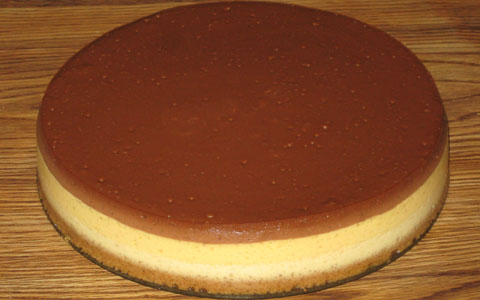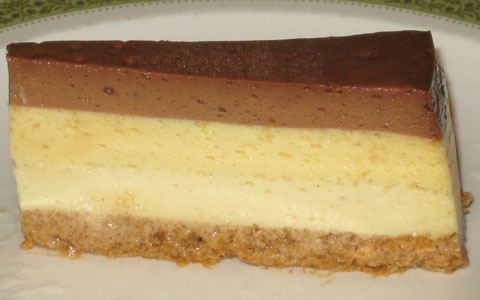|
|
 |
Baked Neapolitan Cheesecake—Prototype 1:
3-Cheese Blend (3CT-1NC-2YG):
Prepare ahead of time 16 ounces of yogurt cheese, derived from one 32-ounce
container of nonfat yogurt. If the resulting yogurt cheese falls below 16
ounces, add back enough of the whey (that was strained out from the yogurt) to
make up the difference. To this yogurt cheese combine 24 ounces of whipped,
lowfat cottage cheese and 8 ounces of softened Neufchatel cheese ("light
cream cheese").
Grease a 9 1/2" (or 9") pan, but do not wrap foil around it until just
before the batter is added (spreading the crust in an already wrapped pan can
result in greater disturbance to the foil, thus increasing leakage risks).
Crust:
2 oz. melted, white chocolate
8 oz. (1 cup) 3-cheese blend (see above)
1/4 cup granulated sugar
1/4 cup brown sugar
1 teaspoon cinnamon
1/2 teaspoon vanilla
2 oz. finely ground All-Bran
Place the resulting mixture in the greased pan and pre-bake without tub at 300
degrees for 5-10 minutes, depending on the mixture's thickness (closer to 10
minutes if thin enough to be fully distributed across the pan's bottom by gentle
shaking, closer to 5 minutes if thick enough to require spreading out this
mixture by pressing on it with a utensil and/or fingers), then cool enough to
comfortably touch at least the pan's upper sidewall.
Vanilla Batter:
1/2 cup + 1 tablespoon + 1 teaspoon (7/12 cup) granulated sugar
13 1/3 oz. (1 2/3 cups) 3-cheese blend (see above)
2 teaspoons vanilla
1/2 teaspoon xanthan gum
2 eggs
Wrap the pan in foil at this point. Carefully pour the batter on top of the
crust and bake all this in a hot water tub at 325 degrees for about 30 minutes.
Afterwards, take the tub-and-pan assembly out of the oven and promptly add the
next batter indicated below.
Strawberry Batter:
1/4 cup + 2 teaspoons granulated sugar
1/3 cup Nestlé Strawberry Nesquik drink mix (the same amount of mix that
would be needed as if to make 2/3 quart of the drink itself)
13 1/3 oz. (1 2/3 cups) 3-cheese blend (see above)
2/3 teaspoon (or 3/4 teaspoon—see comments below) vanilla
1/2 teaspoon xanthan gum
2 eggs
Carefully scoop this on top of the vanilla batter (it is best to do this around
the edge of the pan and let the strawberry batter flow towards the middle) and
return the tub-and-pan assembly to the oven, still at 325 degrees. Resume baking
for about another 30 minutes (if using a 9 1/2" pan). Afterwards, take the
tub-and-pan assembly out of the oven and promptly add the final batter shown
below.
Chocolate Batter:
1/2 cup + 1 tablespoon + 1 teaspoon (7/12 cup) granulated sugar
2 tablespoons cocoa powder
13 1/3 oz. (1 2/3 cups) 3-cheese blend (see above)
2/3 teaspoon (or 3/4 teaspoon—see comments below) vanilla
1/2 teaspoon xanthan gum
2 eggs
Carefully scoop this on top of the strawberry batter (again, it is best to do
this around the edge of the pan and let the chocolate batter flow towards the
middle) and return the tub-and-pan assembly to the oven, this time at only 300
degrees. Bake for about 65 more minutes (if using a 9 1/2" pan). Then shut
off the oven and cool the cheesecake down while still in it (and in tub), with
the oven door slightly ajar, for about an hour. Afterwards, remove the
cheesecake (still in its springform pan) from the oven and tub and continue to
cool it down at room temperature for another two hours.
After cooling down at room temperature, remove the cheesecake from its pan and
refrigerate.


|
|

|


